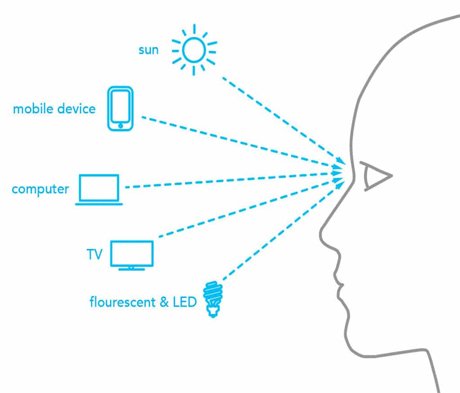In modern families, TV is like an indispensable entertainment partner. Whether with family or alone, we spend more time watching TV. Behind the enjoyment, blue light raises eye health concerns. This article explains why blue light can harm your eyes. It also explores how major TV brands protect your vision. Let it help you choose eye-friendly TVs for your family.
Why blue light hurts the eyes

Blue light is a type of light we can see, and not all blue light is bad. The blue light in nature can help us adjust the daily sleeping and waking up routine and make us more energetic, but the short-wave blue light emitted by the TV screen (like a special kind of light) hides risks. This blue light has high energy and strong penetration, which can cause a lot of damage to the eyes:
Damage to the retina: Short-wave blue light can directly pass through the cornea and lens in front of the eyeball and reach the retina inside the eye. Long-term exposure to this kind of blue light will damage the retinal cells, just like the cells are “tired”, which will affect the clarity of our vision over time.
Increase the possibility of macular degeneration: There is a place called the macula on the retina, where there is a substance called lutein, which can block part of the blue light. But too much short-wave blue light will consume lutein quickly, so that the macula loses its protection and may cause lesions. In severe cases, the middle part will become blurred when looking at things, and it may never recover.
Make the eyes tired and dry: The contrast of blue light is relatively strong, and the eyes have to work hard to see clearly. It is easy to feel sore and swollen, and see things blurry, that is, the eyes are tired. At the same time, it will also destroy the tear film on the surface of the eyes, making the tears evaporate faster, and the eyes will become dry and stinging.
Disrupt the sleep pattern: Blue light affects the secretion of a substance called melatonin in the body, which can help us sleep. If its secretion is disrupted, our sleep pattern will be disrupted and we will not be able to sleep. Poor sleep will prevent the eyes from resting and repairing properly, forming a vicious cycle of “blue light damage – poor sleep – decreased vision”.
Eye protection technology of major brands
Faced with the threat of blue light, mainstream TV brands have come up with many good ways to protect the eyes, while ensuring the effect of watching TV, protecting our vision health:

Hisense Laser TV: A good example of eye protection technology
Hisense Laser TV (such as the Starlight S1 Pro series) has built a full-scale eye protection barrier by improving the light source and imaging method:
Using pure laser as the light source, the wavelength of blue light is controlled above 455nm, cleverly avoiding the harmful blue light of 415-455nm, and also obtained the authoritative Rhine 0 harmful blue light certification, blocking the damage from the source.
The innovative diffuse reflection imaging technology is like imitating the propagation of natural light. The light first hits the screen and then reflects into the eyes. Unlike traditional TVs, the light directly enters the eyes. When watching, it is as comfortable and soft as reading a paper book.
The screen is not powered, so there is no worry about radiation. Coupled with the sophisticated light control technology, the screen brightness is evenly distributed, and there will be no local areas that are too bright to make the eyes feel tired.
TCL TV: Multiple technologies work together to protect the eyes
TCL has formed a full-scene eye protection system through the cooperation of multiple technologies:
Quantum dot TV has anti-blue light technology, which uses special optical materials to block harmful blue light. At the same time, it uses hybrid dimming technology to ensure accurate brightness adjustment without flickering on the screen.
MEMC motion anti-shake is designed for fast-moving scenes. It reduces smearing and motion blur effectively. Your eyes don’t need to refocus constantly. Perfect for watching sports and action movies.
Ambient light sensing adjusts screen brightness and color in real time. It brightens the screen during the day for clarity. At night, it dims slightly to avoid glare. The screen stays comfortable in any lighting environment. Natural light tech mimics sunlight’s gentle, balanced quality. It keeps the screen soft and easy on the eyes. Long viewing sessions feel more natural and less tiring.
Skyworth TV: New use of optical blue light protection technology
Skyworth’s blue light protection is certified by Germany’s TUV Rheinland, so you can watch with confidence. It works by shifting harmful blue light into a safer range—no more worrying about eye strain. The tech is built right into the screen, reducing short-wave blue light without needing extra filters. You still get all the vibrant colors—just without the discomfort. Unlike those yellow-tinted filters, this keeps the picture bright and natural. It’s eye-friendly, family-friendly, and perfect for long hours of watching.
Insignia TV’s consideration of eye protection
Best Buy Insignia TV offers balanced eye protection with strong cost performance. Insignia TV screen avoids strange colors while protecting your eyes. Dual hybrid dimming reduces screen flicker and smooths brightness changes. It eases eye strain, especially for kids and seniors. High-end models auto-adjust brightness and color based on ambient light. For example, it will automatically reduce the proportion of blue light at night, which can ensure that you can see clearly without affecting your sleep.
Today, TV viewing is more common than ever. Eye protection has become a key factor for families choosing TVs. Hisense uses laser diffuse reflection for softer viewing. TCL features multiple eye protection systems across models. Skyworth converts harmful blue light into safer wavelengths. Insignia focuses on balanced, practical eye care design. These technologies prove good TVs protect eyes and picture quality. Choose eye-friendly TVs for clear, comfortable family viewing.
